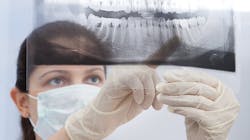Oral manifestations and clinical considerations in patients with Ehlers-Danlos syndrome
Prior to becoming chronically ill, I was a full-time dental hygienist for 12 years. I was very passionate about my career, but my health and tremors cut short my ability to perform clinical hygiene. I am thankful, however, for the knowledge and experience I gained throughout that time period.
Maybe some things have changed since I was in practice in 2015, but Ehlers-Danlos syndrome (EDS) was never discussed when I was in school and taking continuing education courses. For that matter, we rarely touched on any oral manifestations of the less common diseases. It seemed that when disease-related oral manifestations were mentioned, it was always in relation to diabetes or heart disease. I never heard of EDS or any of the other similar connective-tissue diseases that I learned about later. I suppose it makes sense to cover only the more common problems we, as hygienists, would be facing; after all, there is only so much time to devote to the curriculum.
During my chronic illness journey, I found out that chronic Lyme disease was not the only medical issue with which I was dealing. Initially, I had met with a geneticist for my son. He was having some chronic joint pain, and his chiropractor noticed there was hypermobility in several joints. He referred us to a geneticist for an EDS evaluation, since EDS is often an inherited condition.
The geneticist went through our family history and medical history, and also checked my hypermobility. Come to find out, both my son and I had many of the symptoms of hypermobility EDS. I later took a genetic test and discovered that I also have a mutation in a gene related to collagen VI muscular dystrophy, a disease with many of the same symptoms as hypermobility EDS. These diseases can often overlap or present themselves in the same way.
EDS is a connective-tissue disease, typically characterized by tissue fragility, skin hyperelasticity, joint hyperlaxity, keloid scarring, velvety skin, and sometimes vascular manifestations. Collagen defects cause problems for oral health including teeth, gum tissue, nerve tissue, tendons, ligaments, and blood vessels. Each phenotype has its own special characteristics.1 Mouth and jaw symptoms have been found in every phenotype.
Currently, there are eight main known phenotypes of EDS.2 Type VIII happens to be distinctly related to oral manifestations and is called periodontal Ehlers-Danlos syndrome. This is the rarest form of EDS and is characterized by early-onset periodontal disease and hyperpigmented atrophic scars in the pretibial zones. Periodontitis will typically be generalized, cause alveolar bone loss, and lead to possible loss of teeth prior to age 30. Other oral characteristics may include gingival hyperplasia, hyperkeratosis, micrognathia, agenesis or microdontia of multiple teeth, and sometimes increased infection risk.
These collagen diseases often go undiagnosed, but dental professionals are in a key position to notice signs that a collagen disease may be to blame for various oral issues.
Extraoral manifestations
Some extraoral manifestations that may occur include the presence of scarring on the face, hyperelasticity of skin, bruising, hypertelorism, epicanthus, and repeated subluxations of the temporomandibular joint (TMJ). A vaulted palate is common in EDS patients, as are TMJ locking, pain, and laxity. Individuals with EDS can have issues with getting numb from local anesthetic. This could possibly be due to the altered collagen affecting oxygen and nutrient diffusion through the tissue.
Intraoral manifestations
Intraoral manifestations may include a fragile mucosa that tears easily, so sutures may not hold well. The fragility of the mucosa may cause issues with hemorrhaging during dental procedures. Early-onset periodontal disease and recession may occur. Premolar and molar cusps may have extra-deep fissures and long cusps. Hypoplasia of enamel is common. Microdontia is sometimes present, and teeth appear to be fragile. There may also be pulp stones or short deformed roots upon radiographic examination. Up to 50% of EDS patients can touch the tip of their tongue to their nose; this is called the Gorlin sign. Lack of frenula has been noted in some cases.
Clinical considerations
These are some of the clinical considerations regarding patients with EDS.
- Some EDS patients have mitral valve prolapse or other heart conditions. Check if premedication is needed prior to dental treatment. Patients with EDS may need a bite block and frequent breaks to prevent TMJ issues. Neck and lumbar support in the dental chair may be needed.
- Surgical procedures should be avoided, if possible, due to poor wound healing, sutures not holding well, and possible bleeding issues. There is also an increased risk of endocarditis in patients with cardiac valve abnormalities.
- Orthodontic treatment should be lighter because the periodontal ligament is fragile. Bracket placement needs to be away from tissue to avoid mucosal ulcerations. Consider keeping retainers in longer because there is a higher risk of rapid movement.
- There are no special considerations for patients with any type of prostheses or restorations, such as crowns and fillings.
- Endodontic treatment could be complicated if the patient has pulp stones or root deformities.
- There is not much evidence on dental implants and EDS patients, but few side effects are anticipated following regular procedures.
- Periodontal disease should be treated by a periodontal specialist.
- Treatment and management of TMJ-associated problems depend on the cause. Prevention of TMJ injury is important. Lifestyle changes can include changing chewing patterns and using mouth guards, muscle relaxers, anti-inflammatories, and pain medications. Sometimes Botox injections can be used to relax muscles at trigger points. Physical therapy may also be helpful.
Facts about Ehlers-Danlos syndrome
- Testing has proven that those of us with the hypermobility type of EDS do not respond to local anesthetics. We feel it all (or almost all), but we’re often dismissed as hysterics. Needless to say, we hate going to the dentist.
- The joints that connect the jaw to the skull create all sorts of trouble for us (such as TMJ disorder), including hard-core headaches and difficulty chewing. This means you may be jaw-dropping gorgeous, or your jaw just got stuck!
In closing
Research has confirmed that oral manifestations are associated with all forms of EDS. Collagen VI muscular dystrophies are very closely related to EDS. There are not many studies that address the oral manifestations of collagen VI disorders, but it would stand to reason that there may be some similarities to those of EDS considering they both affect the collagen matrix. Certain clinical considerations apply when treating EDS patients. It is paramount that patients with EDS have great oral hygiene to avoid unnecessary invasive treatment. If you are a dental caregiver and witness any of the classical signs of EDS mentioned in this article, a consultation with genetics, cardiology, and/or rheumatology may be indicated to confirm the diagnosis of this condition.
Editor's note: This content was originally published in 2019 but has been updated as of January 2025.
References
1. Mitakides J, Tinkle BT. Oral and mandibular manifestations in the Ehlers-Danlos syndromes. Am J Med Genet C Semin Med Genet. 2017;175(1):220-225. doi:10.1002/ajmg.c.31541. The Ehlers-Danlos Society website. Adapted by Guscott B. https://www.ehlers-danlos.com/2017-eds-classification-non-experts/oral-mandibular-manifestations-ehlers-danlos-syndromes/. Published 2017.
2. US Department of Health & Human Services. National Institutes of Health. National Center for Advancing Translational Sciences. Genetic and Rare Diseases Information Center. Orphanet website. Orpha Number: 75392. Periodontal Ehlers-Danlos syndrome. https://rarediseases.info.nih.gov/diseases/12474/ehlers-danlos-syndrome-periodontitis-type. Updated June 20, 2016. Accessed October 1, 2019.
3. Létourneau Y, Pérusse R, Buithieu H. Oral manifestations of Ehlers-Danlos syndrome. J Can Dent Assoc. 2001;67(6):330-334. ResearchGate website. https://www.researchgate.net/publication/11891940_Oral_manifestations_of_Ehlers-Danlos_Syndrome.
4. Porter S. Oral and dental implications of the Ehler-Danlos syndromes. Ehlers-Danlos Support UK website. https://www.ehlers-danlos.org/information/aaoral-and-dental-implications-of-the-ehlers-danlos-syndromes/. Updated January 4, 2016.
About the Author
Tonya Rebhahn, RDH
Tonya Rebhahn, RDH, spent 12 years working in clinical dental hygiene until chronic illness made it physically impossible to practice. She now advocates for people with chronic illnesses and rare diseases. Contact her by email at [email protected], or you can learn more on her blog, spooniesthriving.com.

